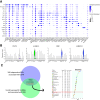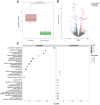Cell Type-Specific Expression of Long Noncoding RNAs in Human Diabetic Kidneys Identifies TARID as a Key Regulator of Podocyte Function
- PMID: 40902080
- PMCID: PMC12585169
- DOI: 10.2337/db25-0272
Cell Type-Specific Expression of Long Noncoding RNAs in Human Diabetic Kidneys Identifies TARID as a Key Regulator of Podocyte Function
Abstract
Long noncoding RNAs (lncRNAs) play essential roles in cellular processes, often exhibiting cell type-specific expression and influencing kidney function. While single-cell RNA sequencing (scRNA-seq) has advanced our understanding of cellular specificity, past studies focus solely on protein-coding genes. We hypothesize that lncRNAs, due to their cell-specific nature, have crucial functions within particular renal cells and thereby play essential roles in renal cell function and disease. Using single-nucleus RNA-seq (snRNA-seq) data from kidney samples of five healthy individuals and six patients with diabetic kidney disease (DKD), we explored the noncoding transcriptome. Cell type-specific lncRNAs were identified, and their differential expression in DKD was assessed. Integrative analyses included expression quantitative trait loci (eQTL), genome-wide association studies (GWAS) for estimated glomerular filtration rate (eGFR), and gene regulatory networks. Functional studies focused on TCF21 antisense RNA inducing promoter demethylation (TARID), a lncRNA with podocyte-specific expression, to elucidate its role in podocyte health. We identified 174 lncRNAs with cell type-specific expression across kidney cell types. Of these, 54 lncRNAs were differentially expressed in DKD. Integrative analyses, including eQTL data, GWAS results for eGFR, and gene regulatory networks, pinpointed TARID, a podocyte-specific lncRNA, as a key candidate upregulated in DKD. Functional studies confirmed TARID's podocyte-specific expression and revealed its central role in actin cytoskeleton reorganization. Our study provides a comprehensive resource of single-cell lncRNA expression in the human kidney and highlights the importance of cell type-specific lncRNAs in kidney function and disease. Specifically, we demonstrate the functional relevance of TARID in podocyte health.
Article highlights: This study provides a resource for kidney (cell type-specific) long noncoding (lnc)RNA expression and demonstrates the importance of lncRNAs in renal health. We identified 174 cell type-specific lncRNAs in the human kidney, with 54 showing altered expression in diabetic kidney disease. TCF21 antisense RNA inducing promoter demethylation (TARID), a podocyte-specific lncRNA upregulated in diabetic kidney disease, is crucial for actin cytoskeleton reorganization in podocytes.
© 2025 by the American Diabetes Association.
Conflict of interest statement
Figures








References
MeSH terms
Substances
Grants and funding
LinkOut - more resources
Full Text Sources
Medical
Research Materials
Miscellaneous

